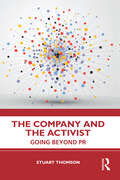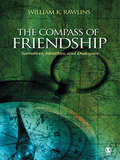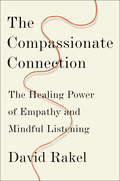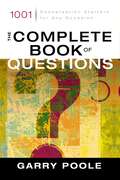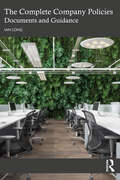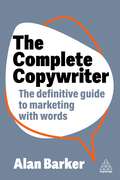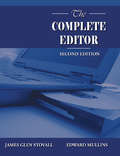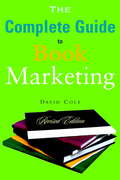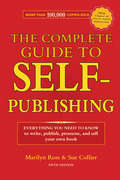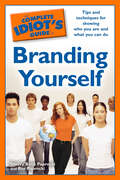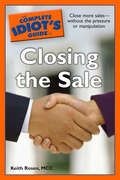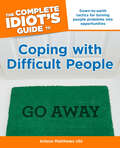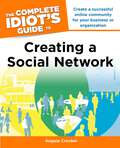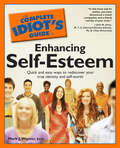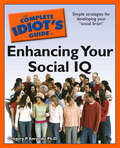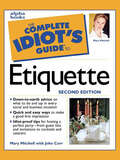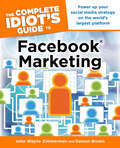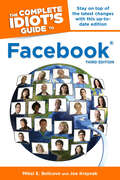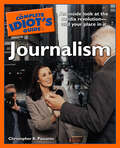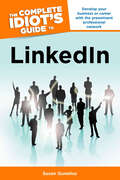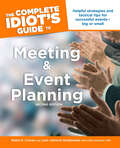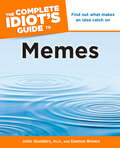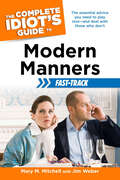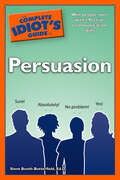- Table View
- List View
The Company and the Activist: Going Beyond PR
by Stuart ThomsonAddressing the rise of a new breed of activists who present a real threat not only to reputations but to business operations, this book explores what businesses need to understand about these communities, why they should be taken seriously, and how business leaders can successfully navigate this shifting terrain.Existing business books address only the communications challenges involved in the rise of these new communities, but this book goes beyond PR issues to the very real impact on business decisions – and acknowledges that businesses must understand activists, and vice versa, if progress is to be made. To lead this conversation, the book includes interviews and contributions from key players across activism and businesses to look at how both sides operate and what success looks like for them. It also features practical steps that businesses can take to build a network of supporters, drawing on global examples from the corporate sector, grassroots campaigns, and people and organisations taking up the mantle of activism.Leaders and professionals working in all aspects of business, across industries and firm types, will appreciate learning about what drives activists and how businesses can work with them to not only avoid reputational damage, but to create stronger connections and, perhaps, a better world.
The Compass of Friendship: Narratives, Identities, and Dialogues
by William K Rawlins2012 Recipient of the Gerald R. Miller Book Award from the Interpersonal Communication Division of the National Communication Association (NCA) <p><p> 2009 Recipient of the David R. Maines Narrative Research Award from the Ethnography Division of the National Communication Association (NCA) <p> Exploring how friends use dialogue and storytelling to construct identities, deal with differences, make choices, and build inclusive communities, The Compass of Friendship examines communication dialectically across private, personal friendships as well as public, political friendships. Author William K. Rawlins uses compelling examples and cases from literature, films, dialogue and storytelling between actual friends, student discussions of cross-sex friendships, and interviews with interracial friends. Throughout the book, he invites readers to consider such questions as: What are the possibilities for enduring, close friendships between men and women? How far can friendship's practices extend into public life to facilitate social justice? What are the predicaments and promises of friendships that bridge racial boundaries? How useful and realistic are the ideals and activities of friendship for serving the well-lived lives of individuals, groups, and larger collectives?
The Compassionate Connection: The Healing Power Of Empathy And Mindful Listening
by David Rakel“This book explains not only the healing power of compassionate human connection, but in the most accessible and practical ways, how to cultivate our capacity to create that connection and thereby empower others to find their best selves.”—John Makransky, author of Awakening through Love All of us have an innate capacity for compassion. We recognize when others are hurting, and we want to help, but we’re not always good at it. There is another way. In The Compassionate Connection, Dr. David Rakel explains how we can strengthen our bonds with others—all the while doing emotional and physical good for ourselves. As founder and director of the University of Wisconsin Integrative Medicine program, Dr. Rakel discovered that we become the most effective helpers when we use the tool of human connection. Drawing on his own research and practice, as well as thirty years of published studies in medicine, sociology, psychology, meditation, and neuroscience, Dr. Rakel "stacks the deck" in favor of healing and introduces the concept of bio-psycho-spiritual authentic awareness. Not only are our bodies and minds connected, but also it has been scientifically proven that our capacity to feel beauty, awe, and compassion enhances our health and wellbeing. In The Compassionate Connection, Dr. Rakel provides an innovative approach to enhancing health in others and strengthening relationships through the art of connecting. These tools guide us to improve our connections—whether between doctor and patient, husband and wife, parent and child, or boss and employee—and live with clarity, wisdom, and good health.
The Complete Book of Questions: 1001 Conversation Starters for Any Occasion
by Garry PooleThis book provides groups with 1,001 engaging and thought-provoking icebreaker questions to start and sustain meaningful conversations.
The Complete Company Policies: Documents and Guidance
by Ian LongThis book is about a much neglected but essential element of the success of any business: company policy. This is a comprehensive guide to determining what policies your company needs, and how to draft and approve the relevant documents and implement them throughout the organization. From anti-bribery laws to data privacy and health and safety, your business is faced with a range of legal and regulatory obligations that must be identified and documented properly. These obligations must be addressed for internal and external stakeholders. The task of identifying and documenting effective policies is an essential step in establishing good corporate governance and ultimately a culture of compliance. These policies in turn provide a solid foundation for the reputation and commercial success of the organization, and form an essential "bridge" between the company’s strategy and the various procedures needed to carry it out. With many useful templates and practical examples, this book will help you to ensure the accuracy and completeness of your policy documents. It covers all areas of your business, including financial reporting, anti-money laundering, anti-fraud, conflicts of interest, data privacy and security, remote working, social media, whistleblowing, and more.This book will be useful to company directors, company secretaries and senior managers, and their advisers, including consultants, auditors, and solicitors. It will be particularly relevant to any business that needs to create or review their policies in light of current regulations and standards.
The Complete Copywriter: The Definitive Guide to Marketing with Words
by Alan BarkerWriting good copy is no longer just about advertising or selling or direct mail. You need to develop a deep understanding of your customers and use your imagination to create and curate content that resonates with them. As marketing becomes more multi-platformed, more measurable and enabled by digital tools and regenerative-AI, marketing communications must be increasingly nuanced, responsive and with a distinct human touch. From paid social to press releases, from landing pages to white papers and from internal communications to engaging with customers, the sheer range of writing challenges can feel daunting. How can you keep it targeted? How can you keep it personal? How can you keep it conversational? The Complete Copywriter gives you all the tools you'll need to create exceptional marketing copy. This comprehensive guide covers every aspect of the copywriting craft, from creativity and planning, to revision and execution. Learn how to exercise your creativity, be refreshingly adaptable with your words, generate ideas, maintain reader attention, hone your empathy and bring words to life, so that you deliver copy that works every time.
The Complete Editor
by James Glen Stovall Edward MullinsFilled with abundant exercises, The Complete Editor provides readers with many resources actively learn about copyediting, headline writing, decision-making, relationships with writers, graphic presentations, photo editing and layout and design. It also contains a separate chapter on legal principles that an editor needs to understand. This efficient and well-written text gives readers basic information about the essential topics at hand.
The Complete Guide to Book Marketing
by David ColeCole, a longtime marketing consultant and previously marketing director of Nolo Press, explains why this is, and what authors, publishers, and self-publishers can do to make works stand out in the crowded marketplace. The revised edition includes low-risk strategies for book marketing in a tight economy (such as marketing reprints and backlist titles), discusses strategies for breaking into the education market, and looks at e-book marketing and print-on-demand.
The Complete Guide to Self-Publishing: Everything You Need to Know to Write, Publish, Promote and Sell Your Own Book
by Marilyn Ross Sue CollierTake Control of Your Destiny! Bottom line: You want to get published. You want to control the future of your manuscript and your writing career. Best-selling author Marilyn Ross and publishing expert Sue Collier show you how to make your own success - whether you're a published author, entrepreneur, corporation, professional, or absolute newcomer to writing. In this expanded and completely revised 5th edition of the "bible" of self-publishing (over 100,000 copies sold), they empower you to publish your own work with minimal risk and maximum profits. You'll find: Complete step-by-step guidance on publishing and marketing a book Ways to leverage social media marketing to build your platform and make yourself stand out from the crowd A thorough explanation of the difference between POD self-publishing, subsidy publishing, and true self-publishing - and how to decide which is the best option for you Practical advice on making the decision between offset printing and print-on-demand How to leverage the Internet to create "buzz" and promote your book with killer PR The latest information on e-publishing A detailed marketing plan and timetable to keep you on track Proven marketing strategies to get free publicity, reach nontraditional buyers, and sell books Information-packed appendices with marketing contacts, organizations, and vendors, complete with names, addresses, and websites Valuable case studies and examples of how other publishers excel An in-depth discussion of exclusive distributors, plus coverage of the most recent changes in bookstores and the book-selling industry Thirty-one creative ideas for generating capital to launch your publishing company The Complete Guide to Self-Publishing is the one book you need to take control of your writing career. Read it. Believe it. Do it. Your future depends on it.
The Complete Idiot's Guide to Book Proposals & Query Letters
by Marilyn Allen Coleen O'SheaInside information from publishing professionals. The Complete Idiot's Guide® to Book Proposals & Query Letters will help writers catch the attention of literary agents with step-by-step instructions on crafting effective queries and proposals for both fiction and non-fiction books that will put them on the road to publication. • The only book on book proposals that also targets a fiction audience • The most comprehensive information on query letters found in any book on writing
The Complete Idiot's Guide to Branding Yourself: Tips and Techniques for Showing Who You Are and What You Can Do
by Ray Paprocki Sherry Beck PaprockiA brand new look at a time-tested business practice Using powerful techniques refined in the heat of business competition, this book guides readers in defining and building a personal brand that is distinctive, relevant, and consistent. It includes: • An in-depth understanding of the principles of successful brand building-in any context • Practical tools to build and manage powerful relationships • Strategies for aligning personal brand values with an employer's brand values, and making brand-building a successful endeavor for both • Advanced techniques to continually refine your unique personal brand
The Complete Idiot's Guide to Closing the Sale: Close More Sales—Without the Pressure or Manipulation
by Keith RosenTraditional and gimmicky closing techniques are dead. Never be scared or reluctant to ask for the sale again and enjoy the confidence and peace of mind in knowing you have a process that works. Tap into Keith Rosen&’s unique, permission-based approach to having a selling conversation with your prospects that fits your style rather than having to &“pitch and close.&” This book gives you the edge over your competition by showing you, step-by-step, how to get to &“yes&” more often by aligning your selling approach with the prospect&’s preferred buying process and communication style without any pressure, manipulation, or confrontation. You&’ll also get exactly what to say in any selling situation, as well as the dialogue that the world&’s greatest salespeople use to defuse objections, ask for the sale, and close the deal. Plus, more than 100 case studies, templates, and scripts you can use with Keith&’s powerful process-driven selling approach. Discover:- The five steps that make your sales presentations objection-proof. - A step-by-step system that prevents cancellations, improves client retention, and boosts referrals. - Proven, permission-based closing strategies that get more prospects to &“yes.&”- The real reasons for price objections and why dropping your price will lose the sale. - Three steps to defuse every objection, especially the ones you create.- Questions you&’re not asking that turn more prospects into clients. - Effective negotiation strategies. - A proven method to boost your confidence and self-esteem—permanently.
The Complete Idiot's Guide to Coping With Difficult People
by Arlene UhlEasy ways of dealing with difficult people. Psychotherapist Arlene Matthews Uhl offers the most effective strategies for dealing with difficult people—from strangers and co-workers to friends and family—by characterizing the four major types and revealing specific methods to cope with them in every aspect of life. - Jargon-free, practical advice and strategies—for home and at work. - Unique approach based on behavioral patterns, not simply personality types. - Includes tactics on diffusing tense encounters in any situation. - Features tips for &“cutting the cord&” when personal relationships become too difficult.
The Complete Idiot's Guide to Creating a Social Network
by Angela CrockerGet connected The Complete Idiot's Guide® to Creating a Social Network takes reader through the technical aspects of creating a successful site-and addresses the responsibilities involved in running one. • Covers how to build and maintain a website through a white label service such as GroupSite or Ning, and by using customized software for creating one's own network • Addresses such issues as privacy, authenticity, fostering participation, quality versus quantity, moral and ethical guidelines, and much more • Americans now average more than six hours per month on social networks, with an active unique social network audience estimated to be from 149 million—up 29 percent from 2009 • Ad revenue taken in by social networking sites is growing rapidly, and many people and companies are looking for ways to get in on this growth
The Complete Idiot's Guide to Enhancing Self-Esteem
by Mark WarnerYou&’re no idiot, of course. You know there are moments when you have been creative, attractive, and even intelligent. But when it comes to sizing yourself up in the mirror, stepping onto a scale to get weighed, or socializing at a party full of extroverts, you feel like a wallflower that hasn&’t been watered in years. Don&’t just stand there with your head in the sand! The Complete Idiot&’s Guide® to Enhancing Self-Esteem shows you how to break through negativity, open yourself to risk and change, and move toward a richer and more integrated life. In this Complete Idiot&’s Guide®, you get: • Straightforward questions that will inspire you to look deeper within yourself. • Self-quizzes that will help you see the &“real you&” more clearly. • Inspirational thoughts and poems. • Insights drawn from the experiences of others. • Common-sense advice on what to do when feeling insecure.
The Complete Idiot's Guide to Enhancing Your Social IQ: Simple Strategies for Developing Your “Social Brain”
by Gregory P. KorgeskiSimple steps to connecting with others. Now readers can raise their social intelligence quotient with a little self-knowledge and practice. Beginning with a series of short quizzes that generate a personal social profile, this guide explains how readers can enhance their ability to create and sustain mutually enriching relationships, make friends, and build a rich social network. • &“Social intelligence&” is the new buzz word in the psychology of relationships. • Includes social personality quizzes. • Hot, new self-help topic. • Author Gregory Korgeski, PhD, has more than 30 years of experience as a licensed psychologist.
The Complete Idiot's Guide to Etiquette, 2e
by Mary MitchellYou&’re no idiot, of course. You know how important it is to handle sticky situations with tact and poise, and that it&’s downright rude to talk with your mouth full or slurp your soup. You&’re always careful to mind your manners, but when you have to make an introduction or attend a business banquet, you feel like a blundering buffoon. Don&’t take your name off the social register just yet! The Complete Idiot&’s Guide® to Etiquette, Second Edition, will show you how to be polished, polite, and professional, whether you&’re at home, at work, or at play. In this Complete Idiot&’s Guide®, you get: • Simple solutions to common dining dilemmas. • Easy-to-follow gift-giving guidelines. • Foolproof ways to prepare a wedding. • Invaluable tips on sports and travel etiquette.
The Complete Idiot's Guide to Facebook Marketing: Power Up Your Social Media Strategy on the World’s Largest Platform
by Damon Brown John Wayne ZimmermanCovers all aspects including Facebook Marketplace, Facebook Places, and Facebook Deals
The Complete Idiot's Guide to Facebook, 3rd Edition: Stay on Top of the Latest Changes with This Up-to-Date Edition
by Joe Kraynak Mikal E. BelicoveFacebook is by far the most popular social networking site, but it is not as user-friendly as the service would like people to think. It leaves many users scratching their heads over even the most fundamental features, such as the difference between their Wall and their News Feed. And Facebook's help system is woefully inadequate. The Complete Idiot's Guide® to Facebook, Third Edition, gets readers registered and touring Facebook in the very first chapter and never lets up as it reveals the features that have made Facebook so amazingly popular. Users discover how to:- Flesh out and protect the all new personal profile- Track down long lost friends, family members, and classmates- Communicate via status updates, email, and chat- Share photos and video- Make the best use of the new Timeline feature- Take advantage of Facebook's new location-based functionality- Schedule real world get-togethers and send out invitations- Share common interests in groups- Play games- Understand Facebook's dizzying array of privacy options that dictate who sees one's content- Buy and sell stuff in the Facebook Marketplace, and more.Readers also learn how to tap the power of Facebook for more than simply personal use-such as personal branding; marketing a business, product, service, or non profit; or promoting a worthy cause.
The Complete Idiot's Guide to Journalism: An Insider Look at the Media Revolution—and Your Place in It
by Christopher K. PassanteBreaking news! This is like having J-school in a book. In recent years, news reporting has dramatically changed. While the basic &“who, what, when, where, and why&” of journalism is still relevant, aspiring journalists are now asking &“how?&” The 21st century of blogs, instant internet access, and 24-hour news shows with minute–by–minute updates has made reporting a whole new—and very competitive—business. Here, a newspaper veteran answers every question about the new world of journalism, and explores every possibility for success.• Covers TV, radio, magazine, newspaper, e-zine, podcast, and internet reporting• Includes a resource list of media outlets, schools, and university programs• Explores different angles for approaching hard news, entertainment, weather, or sports
The Complete Idiot's Guide to LinkedIn: Develop Your Business or Career with the Preeminent Professional Network
by Susan GuneliusDevelop your business or career with the pre-eminent professional network Most people who are new to LinkedIn don't intuitively recognize the potential of the site when it comes to promoting a business, finding a job/project (or being found for one), or raising money for a business venture. The Complete Idiot's Guide® to LinkedIn goes beyond the usual "how to set up and account" and "create a profile" to help readers become LinkedIn super-users and get the most out of the website based on their individual goals. The book provides new users with clear and detailed guidance on: • Filling out the various parts of the LinkedIn profile, customizing it to meet specific professional goals • The right and wrongs ways of doing things on LinkedIn-especially helpful to those used to Facebook• Finding the right people, making the right introductions, and growing and managing networks • Finding and communicating with LinkedIn Groups to help achieve individual business goals • Specific suggestions for using LinkedIn to find a job, market a business, raise capital, and increase sales
The Complete Idiot's Guide to Meeting & Event Planning, 2E
by Lynn Johnson Golabowski Robin E. CravenYou&’re no idiot, of course. You know you can&’t throw a corporate function together overnight—especially if you want to impress clients, shareholders, and upper management. Whether you&’re prepared to tackle the task yourself or you&’re considering hiring a professional, you want your event to be a stellar occasion to remember. The Complete Idiot&’s Guide® to Meeting and Event Planning, Second Edition, will show you how to organize any company gathering on time and on budget, whether you&’re hosting 10 or 10,000. In this revised and updated Complete Idiot&’s Guide®, you get: • Up-to-date information on planning and budgeting software, phone and data lines, audio and video, and satellite bookings. • Expanded coverage on international conferences—via remote, abroad, or by international components. • Ideas for smoothly dealing with last-minute glitches and crises.
The Complete Idiot's Guide to Memes: Find Out What Makes an Idea Catch On
by Damon Brown John GundersThe ways of memes. Memes are "viruses of the mind"—symbols, ideas, or practices that are transmitted through speech, gestures, and rituals. Understanding how symbols like the peace sign or ad slogans like "Where's the beef?" or viral videos become part of our common culture has become a primary focus of sales and marketing companies across the globe. The Complete Idiot's Guide® to Memes explains how memes work, how they spread, and what memes tell us about how we make sense of our world. • First book to cover all types of memes, including viral memes in the digital age • Features the Most Influential Memes in History and the Ten Biggest Internet Memes
The Complete Idiot's Guide to Modern Manners Fast-Track: The Essential Advice You Need to Play Nice—and Deal with Those Who Don’t
by Mary Mitchell Jim WeberTechnology is changing society faster than anyone could have imagined even a few short years ago. People share intimate details to hundreds of acquaintances online, yet they are stumped when it comes to writing a simple thank-you note. They talk, text, and surf on their phones constantly but seem oblivious to the needs of the people who are right in front of them. The Complete Idiot's Guide® to Modern Manners, Fast Track, helps people navigate the uncertain waters of modern social behavior and gives them tips for overcoming the most common miserable moments they're likely to encounter. In it, readers learn how to: Make a good first impression in person, over the phone, in print, and online. Practice good table manners in a world of buffets, informal meals, and a proliferation of restricted diets. Get along with neighbors and their pets, kids, habits, and hobbies. Maintain harmony in the office despite the more casual nature of the workplace. Master the social possibilities of online networking, texting, and smartphones while avoiding embarrassing faux pas. Whip out the old-fashioned pen for written correspondence that makes an impact. Communicate comfortably in person, including small talk, defusing tense situations, and avoiding subjects that are still too uncomfortable for polite conversation. Navigate the difficult situations that arise when traveling and out on the town. Maintain genuine respect for others' differences and disabilities. Be the model of manners at celebrations of life's milestone moments, including weddings and births. Get the right answer to all gift quandaries People are busy and no longer have the time or inclination to comb through Emily Post. This quick book helps readers get the answers they need so they can get on with life.
The Complete Idiot's Guide to Persuasion: Win People Over with Effective Communications Skills
by Steve Booth-ButterfieldGet your way . . . the smart way. Persuasion is the art of changing the way people think, feel, and act through the use of language. The Complete Idiot's Guide® to Persuasion provides strategies for the readers to master the art of persuasion in a positive manner. By using time-honored tools of communication, body language, and psychology, readers can use persuasion to do good things like convince kids to eat their veggies, women to get annual mammograms, and couples to communicate without arguing.• A practical book based on sound academics to help communications and psychology majors as well as businesspeople, salespeople, performers, teachers, and parents• Tips and tactics for writers and public speakers
